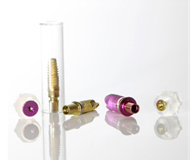 What's a Dental Implant?A dental implant can be thought of as an artificial tooth root that is submerged into the jawbone. A Crown, fixed bridge or a full set of dentures can be permanently fixed to dental implants to replace one or more missing teeth.
What's a Dental Implant?A dental implant can be thought of as an artificial tooth root that is submerged into the jawbone. A Crown, fixed bridge or a full set of dentures can be permanently fixed to dental implants to replace one or more missing teeth.If you have any tooth missing site present in your mouth - after having a tooth removed, either from gum disease or injury infection to a tooth - you will start having localized bone loss around the site(as body believes that no tooth, no bone policy)
Why Would I Need Dental Implants?Dental implants use biocompatible materials that mimic real tooth roots. The job of your jawbone is to nourish your teeth roots, and without teeth, the bone begins a process known as a resorption. In other words, it begins to break down into miNerals and releases into your bloodstream. Dental implants prevent the resorption process, keeping your jaw strong and intact.
Besides, there are some of the many advantages of dental implants:
Besides, there are some of the many advantages of dental implants:
- Without the root structure of a natural tooth the jawbone can shrink making your face look older.
- There are no loose parts. An implant is stable and comfortable.
- Sliding dentures can make chewing difficult. Dental implants function like your own teeth, allowing you to eat your favourite foods with confidence and without pain
- Implants are very durable and will last many years. With good care, many implants last a lifetime.
- Dental Implants LOOK and FEEL like natural teeth.
- Dental Implants don't cause damage to other teeth, as a tooth-supported bridge does. The surrounding teeth are not needed to support the implant, so your healthy teeth are left intact, implants also allow easier access between teeth, improving oral hygiene.

 Why is the surgical procedure a three-step process?
The most widely practiced method of placing dental implants is a "staged surgery" procedure. The first stage consists of surgically burying the implant (which replaces the tooth root) flush with the bone but underneath the gum. This protects the implant from
force while it is healing. At the end of this healing period, the implant needs to be surgically exposed by removing some of the overlying gum.
Why is the surgical procedure a three-step process?
The most widely practiced method of placing dental implants is a "staged surgery" procedure. The first stage consists of surgically burying the implant (which replaces the tooth root) flush with the bone but underneath the gum. This protects the implant from
force while it is healing. At the end of this healing period, the implant needs to be surgically exposed by removing some of the overlying gum.At this second stage, the surgeon checks the implant for its successful integration and connects some form of post which penetrates through the gum into the mouth. This post is called the abutment. Abutments come in many forms and can be stock-manufactured or custom-molded by your dentist and a laboratory. The gum is allowed to heal around the abutment and form a cuff or collar through which the dentist has access to the implant when preparing the final restorative stage of placing the prosthetic tooth or teeth.
Research has shown that it is often possible to place a suitable abutment at the same time as the implant. This has certain limitations but can eliminate the need for a second surgery to expose the implant. However, the implant still requires adequate healing time for the bone to osseo-integrate.
The abutments must also be protected from chewing forces during this period to assure effective bony integration and successful healing. Once the implants have had a chance to heal and have been tested for successful integration, the final restorative step takes place. This stage consists of fabricating and connecting the prosthetic teeth to the successfully osseo-integrated implants.
What is One-Stage Surgery? This method employs a non-submerged one-piece implant that has a metal collar designed to protrude through the gum while the bone is healing to the implant. After a suitable healing time, an abutment can be connected to the implant, allowing for fabrication of the crown to replace the missing tooth. Alternatively, a one-stage technique can be achieved by immediate connection of a temporary healing abutment to a two-piece implant that protrudes through the gum in much the same way as a one-piece implant. Both single stage and two-stage implants have similar success rates and you should ask your dentist which systems they use and discuss how one- or two-stage procedures might be appropriate for you.
What is the overall success rate for dental implants? Despite decades of clinical and scientific research, dental implants do not have a 100% success rate. However, the success rates have improved dramatically since the introduction of dental implant surgery and the dental profession can proudly report success rates well above 90% for most implant patients. Similarly, long-term success rates are in the high 90% range and are likewise improving. When a dental implant has not successfully integrated, it may need to be removed, as it cannot easily be "converted" to osseo-integrate. Your dentist will give you best advice about this. A replacement implant can be placed but it may require some months of healing time and possibly bone augmentation (repair by means of grafting). Likewise, if a previously placed implant has lost significant amounts of supporting bone, there are currently no treatments that can predictably restore the lost bone after it has been in function in the mouth.

